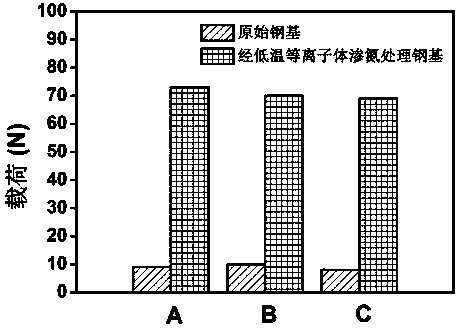A method for increasing binding force between a fullerene-like carbon film and a steel substrate
A fullerene carbon film and enhancement technology, applied in the field of plasma nitriding, can solve the problems of inability to combine ion nitriding and coating, achieve good chemical inertness, strengthen surface technology, and improve binding force
- Summary
- Abstract
- Description
- Claims
- Application Information
AI Technical Summary
Problems solved by technology
Method used
Image
Examples
Embodiment 1
[0025] First, select three stainless steel sheets with a smooth surface, pre-clean them with dilute hydrochloric acid solution, wait for them to dry, then put them into acetone and ethanol for ultrasonic cleaning for 30 minutes each, take out the stainless steel sheets, dry them with ear washing balls, and then quickly transfer them to On the base of the vacuum chamber, start vacuuming. Secondly, wait for the vacuum to be less than 2.0×10 -3 At Pa, argon gas (100 SCCM) was introduced, and the pressure was adjusted to about 20 Pa. Under the condition of pulse bias of -400 V and duty cycle of 50%, plasma cleaning was performed for 30 minutes. After cleaning, nitrogen gas (40 SCCM) was introduced, and the pressure was adjusted to about 30 Pa. Low-temperature plasma nitriding was carried out under the conditions of pulse bias -500 V and duty cycle 50%, and the nitriding time was 2 hours. Finally, a fullerene-like carbon film is deposited on the surface of the treated steel subst...
Embodiment 2
[0027] First, six stainless steel sheets with smooth surface are selected, three of which have been treated with low-temperature plasma nitriding, and the other three have not been treated with low-temperature plasma nitriding. Carbon films were then deposited on the surfaces of the six steel substrates. as figure 1 As shown, the binding force between the steel substrate and the fullerene-like carbon film after low-temperature plasma nitriding treatment can reach about 70N, while the binding force between the steel substrate and the fullerene-like carbon film without low-temperature plasma nitriding treatment is only 10N about. Repeat the experiment three times to ensure the accuracy of the experimental results. It shows that the low-temperature plasma nitriding method can greatly improve the bonding force between the steel substrate and the fullerene-like carbon film, and the bonding force can be increased by 600%.
PUM
 Login to View More
Login to View More Abstract
Description
Claims
Application Information
 Login to View More
Login to View More - R&D
- Intellectual Property
- Life Sciences
- Materials
- Tech Scout
- Unparalleled Data Quality
- Higher Quality Content
- 60% Fewer Hallucinations
Browse by: Latest US Patents, China's latest patents, Technical Efficacy Thesaurus, Application Domain, Technology Topic, Popular Technical Reports.
© 2025 PatSnap. All rights reserved.Legal|Privacy policy|Modern Slavery Act Transparency Statement|Sitemap|About US| Contact US: help@patsnap.com

